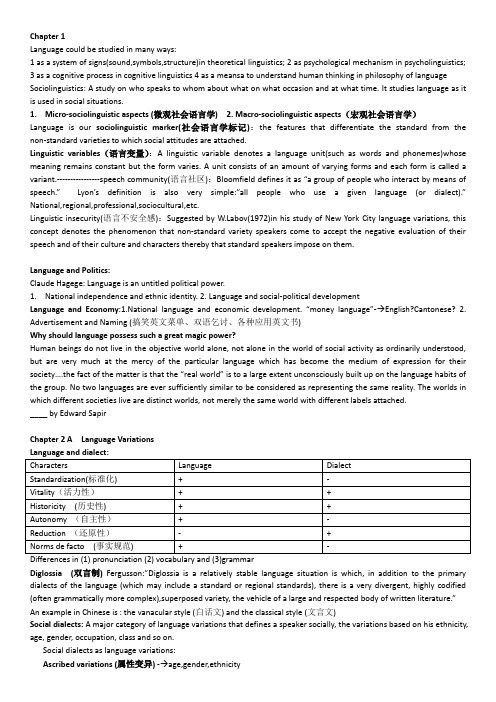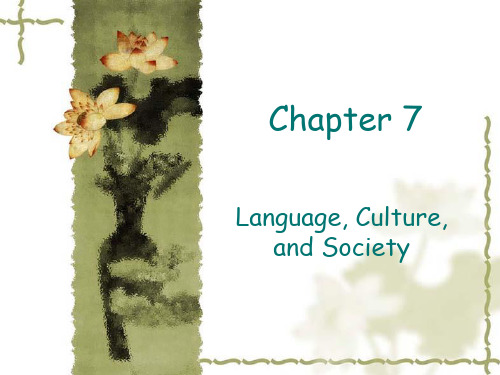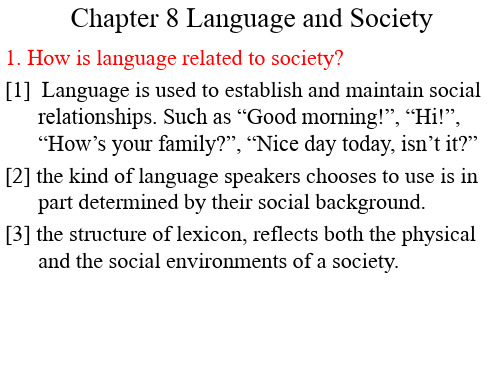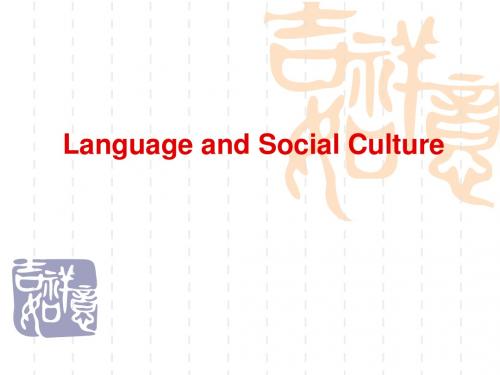Language and society-GAOYUAN
- 格式:ppt
- 大小:467.50 KB
- 文档页数:50

Chapter 1Language could be studied in many ways:1 as a system of signs(sound,symbols,structure)in theoretical linguistics;2 as psychological mechanism in psycholinguistics;3 as a cognitive process in cognitive linguistics4 as a meansa to understand human thinking in philosophy of language Sociolinguistics: A study on who speaks to whom about what on what occasion and at what time. It studies language as it is used in social situations.1.Micro-sociolinguistic aspects (微观社会语言学)2. Macro-sociolinguistic aspects(宏观社会语言学)Language is our sociolinguistic marker(社会语言学标记):the features that differentiate the standard from the non-standard varieties to which social attitudes are attached.Linguistic variables(语言变量):A linguistic variable denotes a language unit(such as words and phonemes)whose meaning remains constant but the form varies. A unit consists of an amount of varying forms and each form is called a variant.----------------speech community(语言社区):Bloomfield defines it as “a group of people who interact by means of speech.”Lyon’s definition is also very simple:”all people who use a given language (or dialect).”National,regional,professional,sociocultural,etc.Linguistic insecurity(语言不安全感):Suggested by bov(1972)in his study of New York City language variations, this concept denotes the phenomenon that non-standard variety speakers come to accept the negative evaluation of their speech and of their culture and characters thereby that standard speakers impose on them.Language and Politics:Claude Hagege: Language is an untitled political power.1.National independence and ethnic identity.2. Language and social-political developmentLanguage and Economy:1.National language and economic development. “money language”-→English?Cantonese? 2. Advertisement and Naming (搞笑英文菜单、双语乞讨、各种应用英文书)Why should language possess such a great magic power?Human beings do not live in the objective world alone, not alone in the world of social activity as ordinarily understood, but are very much at the mercy of the particular language which has become the medium of expression for their society….the fact of the matter is that the “real world” is to a large extent unconsciously built up on the language habits of the group. No two languages are ever sufficiently similar to be considered as representing the same reality. The worlds in which different societies live are distinct worlds, not merely the same world with different labels attached.____ by Edward SapirChapter 2 A Language VariationsDiglossia (双言制)Fergusson:”Diglossia is a relatively stable language situation is which, in addition to the primary dialects of the language (which may include a standard or regional standards), there is a very divergent, highly codified (often grammatically more complex),superposed variety, the vehicle of a large and respected body of written literature.”An example in Chinese is : the vanacular style (白话文) and the classical style (文言文)Social dialects: A major category of language variations that defines a speaker socially, the variations based on his ethnicity, age, gender, occupation, class and so on.Social dialects as language variations:Ascribed variations (属性变异) -→age,gender,ethnicityAcquired variations(习得变异) –> class, occupation and education, roles.Note: when a regional dialect acquires social significance, it becomes a sociolect.Ascribed variation I----age:1 generational differences as indicators of a language change 2 age differences as reflecting the age-grading (年龄极差).Rice: Argot(隐语、行话) is a shorthand device to save elaborate explanation and time; Adolescent argot is coined to make possible a more precise reference to certain observations or experiences than the ordinary adult vocabulary would allow; Adolescent argot also is used as a reinforce and maintainer of group solidarity.Generally, old people are more conservative and resistant to changes and novelties, while the young are innovative or at least novelty-happy.Ascribed variation Ⅱ-----Gender:Characteristics of female speech (English, Obarr,1980):1)Hedges, such as “sort of””kind of “”I guess”2)Super-polite forms, such as “would you please…”“I’d really appreciate…”3)Tag questions, such as “didn’t they?””isn’t it?”4)Using emphatic form, such as the emphatic “so””very”5)Empty adjectives, such as “divine””charming””sweet”6)Hypercorrect grammar and pronunciation (as if in formal address)7)Direct speech more than indirect speech8)Question intonation in declarative contextsIn addition, these words are ordinarily ruled out:”Damn it!””Shit!”a nd the so-called “four-letter” ones.]1.Power language vs. powerless language;2. Women’s role in conversation;3.Women’s tendency to be status-concerned:they use of standard speech more than men do. Tendency to being over-polite--→a fear of being negatively evaluated,a perceived inferiority. 4. The issue of feminism: When carried to an extreme, feminism may appear to beridiculous.”mankind,chairman”-→”people, chairperson”,but”history”-→”nistory”?Ascribed variation Ⅲ----- Ethnicity:Two issues: 1.ethnic identity: pronunciation: I fink, Ha dya hep me? Synatx: AE vs. BE 2. Necessity of using mainstream standard: standardization vs. counter-standardization , social mobility and standard language, economic status and standardizationChapter2 BAcquired variation I----Class: operationally defined in terms of income, housing and occupation. All classes speak the same language (Chinese,English,etc.),or else, communication is impossible. But different classes do have their own way of speaking.There is one issue concerning class variation: Berstein’s hypothesis(London University,1971): Elaborated code(复杂语码) vs. restricted code (限制语码).The elaborated code is a way of speaking, explicit with fewer assumption about the hearer’s knowledge.复杂语码是一种清楚明晰的说话方式,不假定听话人对所谈内容具备知识。





LanguageCultureandsociety语言学Language,Culture and society 语言学Sociolinguistics ---- a sub-field of linguists that studies the relation between language and society, between the uses of language and the social structures in which the users of language live.Language,Culture and society 语言学In a broad sense, culture means the total way of life of a people, including the patterns of belief, customs, objects, institutions, techniques, and language that characterizes the life of the human community. In a narrow sense, culture may refer to local or specific practice, beliefs or customs, which can be mostly found in folk culture, enterprise culture or food culture, etc. There are generally two types of culture: material and spiritual.Language,Culture and society 语言学The same word may stir up different associations in people under different cultural background, e.g. the word “dog”. Language expresses cultural reality, reflects the people’s attitudes, beliefs, world outlooks, etc. The culture both emancipates and constrains people socially, historically and metaphorically. Culturealso affects its people’s imagination or common dreams which are mediated through the language and reflected in their life. On the one hand, language as an integral part of human being, permeates in his thinking and way of viewing the world, language both expresses and embodies cultural reality; on the other, language, as a product of culture, helps perpetuate the culture, and the changes in language uses reflect the cultural changes in return.Language,Culture and society 语言学Edward Sapir and Benjamin Whorf, proclaimed that the structure of the language people habitually use influences the ways they think and behave, i.e. different languages offer people different ways of expressing the world around, they think and speak differently, this is also known as linguistic relativity. Sapir and Whorf believe that language filters people’s perception and the way they categorize experiences. This interdependence of language and thought is now known as Sapir-Whorf Hypothesis.Language,Culture and society 语言学Strong version believes that the language patterns determine people’s thinking and behavior; Weak version holds that the former influence the latter. ----The study of the linguisticrelativity or SWH has shed two important insights: There is nowadays a recognition that language, as code, reflects cultural preoccupations and constrains the way people think. More than in Whorf’s days, however, we recognize how important context is in complementing the meanings encoded in the language.Language,Culture and society 语言学Denotative meaning ---- a meaning that can be found in a dictionary. Connotative meaning ---- a meaning or idea suggested by a word or thing in addition to the formal meaning or nature of the word or thing. Iconic meaning ---- the image or icon invoked in mind by a word. For example, “rose”.Language,Culture and society 语言学Greetings and terms of address Thanks and compliments Color words Privacy and taboos Rounding off numbers Words and cultural-specific connotations Cultural-related idioms, proverbs and metaphorLanguage,Culture and society 语言学Learning a foreign language is inseparable from learning its culture. We need to learn enough about the language’s culture so that we can communicate in the target language properly to achieve not only the linguistic competence but also the pragmaticor communicative competence as well.Language,Culture and society 语言学Cultural overlap refers to the identical part of culture between two societies owing to some similarities in the natural environment and psychology of human beings. For example, the superior tends to refer to himself or herself by means of kinship terms, such as“Have daddy/mummy/teacher told you that?”Language,Culture and society 语言学Through communication, some elements of culture A enter culture B and become part of culture B, this phenomenon is known as cultural diffusion. One typical example of cultural diffusion is the appearance of loan words. (肥皂剧、卡通、布丁、苹果派、雀巢、巴士、因特网、KTV、EMAIL; Typhoon、gongfu) The practice of observing holidays of foreign origins and accepting concepts from other cultures.。
Chapter 8 Language And Society1. Language is not only used to communicate meaning, but also used to establishand maintain social relationships.1. The relatedness between language and society2. The users of the same language in a sense all speak differently related to their语言和社会的关联social background.3. The structure of language vocabulary is different,reflects both the physical andsocial environments of a society.There are different words about snow in Eskimo.1.The scope of sociolinguistics 1. Speech community (linguistic community) : is widely used by sociolinguists to refer to社会语言学范围 2. Speech community and speech variety a community mainly based language. It’s generally defined as a group of people who言语社团和言语变体have the opportunity to interact with each other and there are exist various social groupsdefined not only by the speaker’s geographical background, but also by their educationalbackground, their occupation, gender, age, or ethnic affiliation.2. Speech variety, or language variety, refers to any distinguishable form of speech usedby a speaker or a group of speakers. Linguistic features of a speech variety can be foundat the lexical, the phonological, the morphological, or the syntactical level of the languageThree types of speech variety: regional dialects, sociolects and registers.3. Two approaches to sociolinguistic studies1 Regional dialect: is a linguistic variety used by people living in the same geographical region. (同一地理区域使用的)2.V arieties of language 2 sociolect: refers to the linguistic variety characteristic of a particular social class. (特定社会阶层使用的)语言的各种变体 1. Dialectal varieties 3 language and gender.女性的语言比男性“更正确”原因在女性对自己身份更看重(more status-conscious)4 idiolect: is a personal dialect of an individual speaker that combines elements regarding regional, social, gender and age5 language and age6 ethnic dialect; is a social dialect of a language that cuts across regional differences; it’s mainly spoken by a lessprivileged population that has experienced some form of social isolation such as racial discrimination and segregation1. Field of discourse语场:指社会行为的类型,即正在进行的活动的领域和目的,包括谈话的主题。